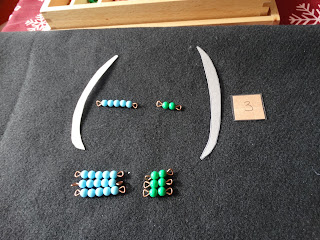Nito was shown another presentation in the sequence for Distributive Law for Multiplication. It seems that I have never posted anything for the Commutative Law, which is usually a prerequisite for this presentation. I'll have to get on that! However, I do show at the end of this presentation how to check your answer using the Commutative Law.
As I mentioned above, he has done the presentations on the Commutative Law, the exchanging of the multiplier with the multiplicand. For this presentation, I chose a sum of two numbers for the multiplicand. In the picture above, I chose 5 and 2. Since I am considering it a sum, he puts parentheses around the two bead bars. He will take this sum 3 times. He uses a brown 3 card and places it on the outside of the parenthesis. Ok, now ideally the child uses a gray card, but all I had on hand was brown construction paper when I made these materials. I mean, who has time to drive 45m-1 hour round trip to Michael's with 6 kids just to get gray paper?! Honestly, it doesn't matter the color paper, as long as it isn't white.
This is the box of bead bars that he uses. It is a bit different from the checkerboard bead box because this one includes the ten bars.
What does taking this sum 3 times mean? It means taking the 5 bar 3 times and the 2 bar 3 times. The blue beads are the 5 bars and the green are the 2 bars.
Then the value is calculated and placed underneath the respective columns (15 and 6).
Then the beads are pushed together.
Now, the beads are exchanged to make a single number of 21.
Commutative Law Check
Since the child knows the commutative law, he can check his answer. It says if you exchange the multiplier with the multiplicand, then you should get the same answer. Nito laid out the problem after exchanging beads for tickets and tickets for beads. In the picture above, the distributive law is on the left hand side and the commutative law is on the right hand side. He laid out a 3 bead bar and now has a 5 and 2 brown card inside the parentheses.
He begins by taking the 3 bead bar 5 times and then takes it 2 times. He finds the answer and places the single number below.
This picture shows that the commutative law on the right hand side has an answer of 21 which matches his distributive law answer of 21. His work checked out!









No comments:
Post a Comment